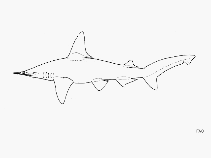http://www.fishbase.org/Summary/speciesSummary.php?genusname=Sphyrna&speciesname=tudes ---> http://192.134.151.83/Summary/speciesSummary.php?genusname=Sphyrna&speciesname=tudes
http://192.134.151.83/Summary/speciesSummary.php?genusname=Sphyrna&speciesname=tudes ---> https://fishbase.mnhn.fr/Summary/speciesSummary.php?genusname=Sphyrna&speciesname=tudes
https://fishbase.mnhn.fr/Summary/speciesSummary.php?genusname=Sphyrna&speciesname=tudes ---> https://fishbase.mnhn.fr/summary/Sphyrna-tudes.html
Sphyrna tudes, Smalleye hammerhead : fisheries

You can
sponsor
this page
Common name (e.g. trout)
Genus + Species (e.g. Gadus morhua)
-

-
About this page
-
Languages
-
User feedbacks
-
Citation
-
Uploads
-
Related species
-


 Smalleye hammerhead
Add your observation in
Fish Watcher
Upload your
photos
and
videos
Smalleye hammerhead
Add your observation in
Fish Watcher
Upload your
photos
and
videos
Pictures
|
Google image
 Sphyrna tudes
Sphyrna tudes
Picture by
FAO
Elasmobranchii (sharks and rays) >
Carcharhiniformes
(Ground sharks) >
Sphyrnidae
(Hammerhead, bonnethead, or scoophead sharks)
Etymology:
Sphyrna:
Probable misspelling of
sphyra
(Gr.), hammer, referring to their hammer-shaped heads. (
See ETYFish
)
;
tudes:
Latin for hammer, referring to its hammer-shaped head. (
See ETYFish
)
.
More on author:
Valenciennes
.
Environment: milieu / climate zone / depth range / distribution range
Ecology
Marine; benthopelagic, usually ? - 12 m (Ref.
244
). Subtropical; 46°N - 57°S, 73°W - 37°E (Ref.
244
)
Southwest Atlantic: Venezuela to Argentina (Ref.
58839
). Also Mediterranean Sea and Eastern Pacific (Ref.
7251
).
Size / Weight / Age
Maturity: L
m
?
range ? - ? cm
Max length : 134 cm TL male/unsexed; (Ref.
244
); 148.0 cm TL (female)
A little-known inshore shark of the continental shelf, found down to at least 12 m depth. Feeds on small bony fishes, including sea catfish and grunts, but also newborn scalloped hammerheads, swimming crabs, squids, and shrimp. Viviparous with a yolk-sac placenta; number of young probably 6 to 9 per litter (Ref.
244
).
Life cycle and mating behavior
Maturity
|
Reproduction
|
Spawning
|
Eggs
|
Fecundity
|
Larvae
Viviparous, with yolk-sac plazenta; number of young probably 6 - 9 per litter. Size at birth about 30 cm.
Compagno, L.J.V.
, 1984. FAO Species Catalogue. Vol. 4. Sharks of the world. An annotated and illustrated catalogue of shark species known to date. Part 2 - Carcharhiniformes. FAO Fish. Synop. 125(4/2):251-655. Rome: FAO. (Ref.
244
)
IUCN Red List Status (Ref.
130435
)
Critically Endangered (CR)
(A2bd); Date assessed:
01 July 2019
CITES
Appendix II:
International trade monitored
Not Evaluated
Threat to humans
Harmless
Human uses
Fisheries: subsistence fisheries
FAO - Publication:
search
| FIRMS -
Stock assessments
|
FishSource
|
More information
Countries
FAO areas
Ecosystems
Occurrences
Introductions
Stocks
Ecology
Diet
Food items
Food consumption
Ration
Common names
Synonyms
Metabolism
Predators
Ecotoxicology
Reproduction
Maturity
Spawning
Spawning aggregation
Fecundity
Eggs
Egg development
Age/Size
Growth
Length-weight
Length-length
Length-frequencies
Morphometrics
Morphology
Larvae
Larval dynamics
Recruitment
Abundance
BRUVS
References
Aquaculture
Aquaculture profile
Strains
Genetics
Electrophoreses
Heritability
Diseases
Processing
Nutrients
Mass conversion
Collaborators
Pictures
Stamps, Coins Misc.
Sounds
Ciguatera
Speed
Swim. type
Gill area
Otoliths
Brains
Vision
Tools
E-book
|
Field guide
|
Identification keys
|
Length-frequency wizard
|
Life-history tool
|
Point map
|
Classification Tree
|
Catch-MSY
|
Special reports
Check for Aquarium maintenance
|
Check for Species Fact Sheets
|
Check for Aquaculture Fact Sheets
Download XML
Summary page
|
Point data
|
Common names
|
Photos
Internet sources
AFORO (otoliths) |
Aquatic Commons
|
BHL
|
Cloffa
|
BOLDSystems
|
Websites from users
|
Check FishWatcher
|
CISTI
|
Catalog of Fishes
:
genus
,
species
|
DiscoverLife
|
ECOTOX
| FAO - Publication:
search
|
Faunafri
| Fishipedia |
Fishtrace
| GenBank:
genome
,
nucleotide
|
GloBI
|
Google Books
|
Google Scholar
|
Google
| IGFA World Record |
MitoFish
|
National databases
|
Otolith Atlas of Taiwan Fishes
|
PubMed
| Reef Life Survey | Socotra Atlas |
Tree of Life
| Wikipedia:
Go
,
Search
| World Records Freshwater Fishing |
Zoological Record
Estimates based on models
Preferred temperature (Ref.
123201
): 17.6 - 27.8, mean 21.1 °C (based on 613 cells).
Phylogenetic diversity index (Ref.
82804
): PD
50
= 0.5029 [Uniqueness, from 0.5 = low to 2.0 = high].
Bayesian length-weight: a=0.00347 (0.00157 - 0.00767), b=3.12 (2.93 - 3.31), in cm total length, based on LWR estimates for this (Sub)family-body shape (Ref.
93245
).
Trophic level (Ref.
69278
): 3.6 ±0.4 se; based on diet studies.
Resilience (Ref.
120179
): Very Low, minimum population doubling time more than 14 years (Fec=6).
Fishing Vulnerability (Ref.
59153
): Very high vulnerability (89 of 100).
Price category (Ref.
80766
):
High
.
Back to Search
Random Species
Back to Top
Accessed through:
Not available
FishBase mirror site :
localhost
Page last modified by :
mrius-barile
- 20 July 2016
Fatal error
: Uncaught ArgumentCountError: Too few arguments to function checkEcotox(), 1 passed in /var/www/html/summary/speciessummary.php on line 2304 and exactly 3 expected in /var/www/html/includes/speciessummary.lib.php:2579 Stack trace: #0 /var/www/html/summary/speciessummary.php(2304): checkEcotox() #1 {main} thrown in
/var/www/html/includes/speciessummary.lib.php
on line
2579
|